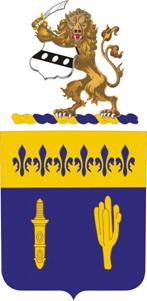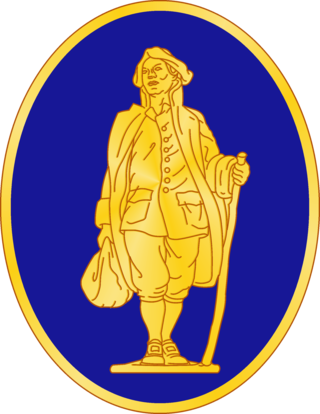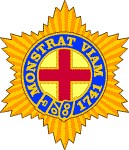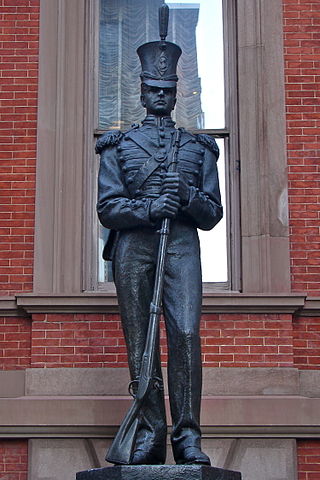
The Philadelphia nativist riots were a series of riots that took place on May 6—8 and July 6—7, 1844, in Philadelphia, Pennsylvania, United States and the adjacent districts of Kensington and Southwark. The riots were a result of rising anti-Catholic sentiment at the growing population of Irish Catholic immigrants. The government brought in over a thousand militia—they confronted the nativist mobs and killed and wounded hundreds.

The 28th Infantry Division ("Keystone") is a unit of the Army National Guard and is the oldest division-sized unit in the Department of Defense. Some of the units of the division can trace their lineage to Benjamin Franklin's battalion, The Pennsylvania Associators (1747–1777). The division was officially established in 1879 and was later redesignated as the 28th Division in 1917, after the entry of America into the First World War. It is today part of the Pennsylvania Army National Guard, Maryland Army National Guard, Ohio Army National Guard, and New Jersey Army National Guard.

The 69th Pennsylvania Infantry was an infantry regiment in the Union army during the American Civil War.

The New York Army National Guard is a component of the New York National Guard and the Army National Guard. Nationwide, the Army National Guard comprises approximately one half of the United States Army's available combat forces and approximately one third of its support organization. National coordination of various state National Guard units are maintained through the National Guard Bureau.

The Pennsylvania Army National Guard, abbreviated PAARNG, is part of the United States Army National Guard and is based in the U.S. Commonwealth of Pennsylvania. Together with the Pennsylvania Air National Guard, it is directed by the Pennsylvania Department of Military and Veterans Affairs. The PAARNG maintains 124 armories and is present in 87 communities across the Commonwealth.

The 112th Infantry Regiment, also known as the Sixteenth Pennsylvania, is a unit in the Pennsylvania National Guard which can trace its lineage back to before the American Civil War.

The 118th Pennsylvania Regiment was a volunteer infantry regiment in the Union Army during the American Civil War. They participated in several major conflicts during the war including the Battle of Gettysburg, Siege of Petersburg, and escorted the truce flag of Robert E. Lee at the Battle of Five Forks. The regiment was led by Colonel Charles Prevost until he was seriously injured at the Battle of Shepherdstown in which Lieutenant-Colonel James Gwyn assumed command until the end of the war.

The Maryland Army National Guard is the United States Army component of the U.S. state of Maryland. It is headquartered at the old Fifth Regiment Armory at the intersection of North Howard Street, 29th Division Street, near Martin Luther King, Jr. Boulevard in Baltimore and has additional units assigned and quartered at several regional armories, bases/camps and other facilities across the state.

Associators were members of 17th- and 18th-century volunteer military associations in the British American thirteen colonies and British Colony of Canada. These were more commonly known as Maryland Protestant, Pennsylvania, and American Patriot and British Loyalist colonial militias. But unlike militias, the associator military volunteers were exempt from regular mandatory military service. Other names used to describe associators were "Associations", "Associated", "Refugees", "Volunteers", and "Partisans".

The 109th Infantry Regiment is a parent infantry regiment of the United States Army, represented in the Pennsylvania Army National Guard by the 1st Battalion, 109th Infantry, part of the 2nd Brigade Combat Team, 28th Infantry Division.
The Second Army Corps was a unit of the United States Army raised for the Spanish–American War. A defining event of the Spanish–American War was the typhoid fever epidemic of July to November 1898. The Army consequently undertook a series of mass-retreats and attempted evasions. The Typhoid Board concluded that only one of the five army corps stricken with epidemic typhoid succeeded in suppressing the disease actively, the 2nd Army Corps. In the wake of two fruitless relocations and months of casualties, commanders finally managed to impose an effective latrine-policy. A three-part strategy of draconian defecation-management, mass-disinfection, and flight received the Typhoid Board's imprimatur as the principal, recommended method for suppressing existing epidemics.

The 111th Infantry Regiment, was originally the Pennsylvania Militia or "Associators" that fought in the American Revolution, composed of civilian males from the citizenry of Pennsylvania. It is one of several National Guard units with colonial roots and campaign credit for the War of 1812. The Pennsylvania Militia often fought in conjunction with General Washington and the Continental Army along the Delaware River. Today the idea of a Pennsylvania Militia is represented in the U.S. Army by 1st Battalion, 111th Infantry assigned to the Pennsylvania Army National Guard's 56th Stryker Brigade Combat Team, 28th Infantry Division. The regiment, founded as the Associators by Benjamin Franklin in Philadelphia, Pennsylvania on 21 November 1747, is the oldest regiment in Pennsylvania.

The First Corps of Cadets of Massachusetts formed in 1741. Its motto is Monstrat Viam - "It Points the Way." While it has served in several wars, the sub-unit's primary contribution to Massachusetts and to the United States was as an officer-producing institution for new regiments from the Revolutionary War through World War II.
Twenty-four current units of the Army National Guard perpetuate the lineages of militia units mustered into federal service during the War of 1812. Militia units from nine states that were part of the Union by the end of the War of 1812, plus the District of Columbia, are the predecessors of eighteen units that currently exist in the Army National Guard. Two of the four units derived from Virginia militias are in the West Virginia National Guard; at the time of the War of 1812, West Virginia was still part of Virginia. Only two current units, the 155th Infantry, a component of the Mississippi National Guard derived from militia units organized in the Mississippi Territory and the 130th Infantry, a component of the Illinois National Guard derived from militia units formed in the Illinois Territory, are from states or territories west of the Appalachians. Unfortunately, no militia units from the states of Kentucky, Louisiana, Ohio or Tennessee, or from the Indiana, Michigan, Missouri or Louisiana Territories, where militia units played a major role in the fighting, have survived as units in the modern Army National Guard.

The 1st Battalion, 108th Field Artillery Regiment, 56th Stryker Brigade Combat Team, is the only direct support field artillery battalion in the only National Guard Stryker Brigade in the United States Army.

The Washington Grays of Philadelphia was a volunteer regiment which functioned during peace and war. The regiment was formed in 1822 and was eventually integrated into the Pennsylvania National Guard in 1879. John Oppell Foering wrote, "Without question [the Washington Grays] have been the parent and pattern of the militia of the City and State, as well as the foundation upon which was erected the magnificent National Guard of Pennsylvania if not of the entire country."

The 55th Maneuver Enhancement Brigade is a maneuver enhancement unit aligned under the 28th Infantry Division of the Pennsylvania Army National Guard. The 55th MEB, like all MEBs, is a self-contained, modular, and multifunctional support brigade of the United States Army with an ability to plug into operational formations commanded by corps or division commanders, to support brigade combat teams once deployed, and to conduct tactical level tasks and support. MEBs are equipped to provide command and control for up to seven battalions that are capable of owning battlespace in combat. The 55th MEB was once the 55th Heavy Brigade Combat Team "strike brigade" subordinate to the 28th ID, as the 55th MEB is today. Its headquarters is in Scranton, PA.

Fatland – also known as "Fatland Farm," "Fatland Ford" and, currently, "Vaux Hill" – is a Greek Revival mansion and estate in Audubon, Pennsylvania. Located on the north side of the Schuylkill River, opposite Valley Forge, the property was part of the Continental Army's 1777-78 winter encampment. On consecutive days in September 1777, its stone farmhouse served as headquarters for General George Washington and British General Sir William Howe.
The Queen's Edinburgh Light Infantry Militia was an auxiliary regiment raised in and around the city of Edinburgh in Scotland. It was formed in 1798 and reformed in 1802, but had links with earlier Fencible and Volunteer units from the area. It served in home defence during the Napoleonic Wars and the Crimean War. Later it became a battalion of the Royal Scots and saw active service in South Africa during the Second Boer War. It served as a Special Reserve training unit in World War I, but after 1921 the militia had only a shadowy existence until its final abolition in 1953.


















